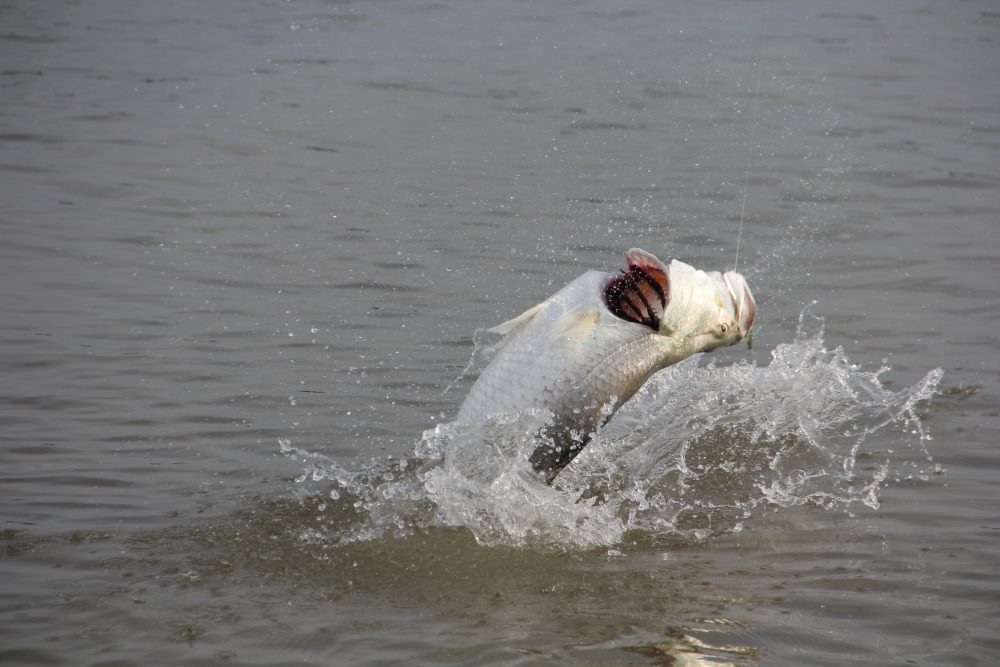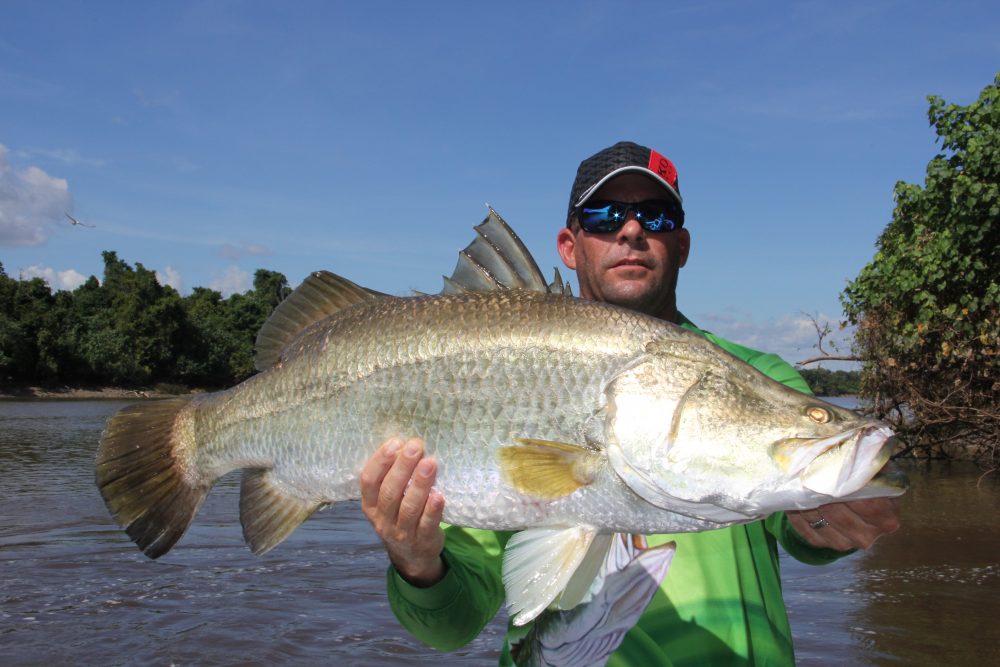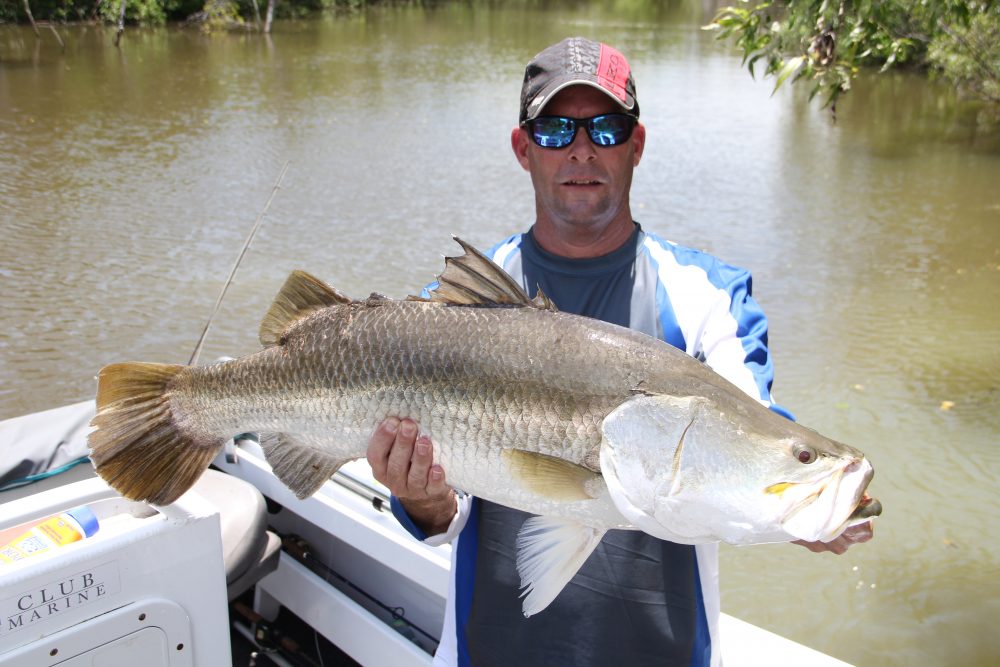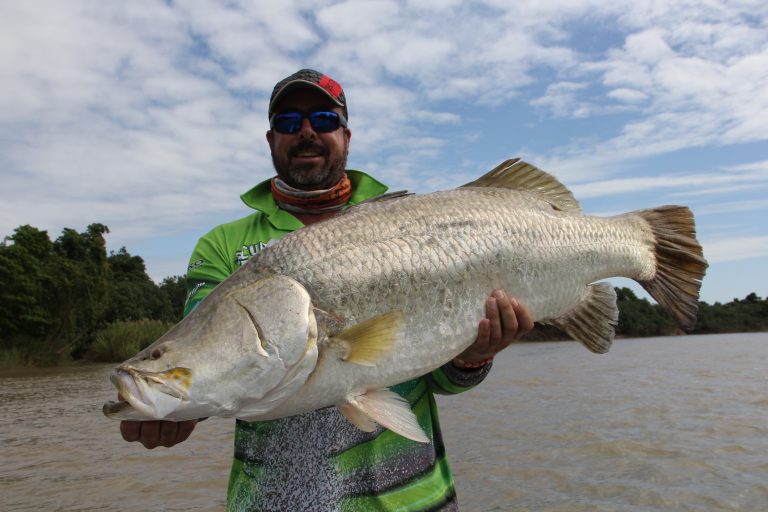Trolling Tips for the Daly River By – Chris Erity
The Daly River in the Northern Territory is one of the most picturesque rivers to fish and due to its relatively close proximity to Darwin is an extremely popular waterway to target large barramundi. The Daly River fishes very well all year round except when it is in peak flood. However, some of the best fishing occurs around April to June particularly when your preferred method of fishing is trolling. The Daly River is riddled with structure, sand bars and rock bars, which all fish well for barramundi at this time of year. However, these areas require different methods when trolling. The tides also greatly influence this mighty river and hopefully this article will give you some useful tips on trolling the Daly River, taking into account all of these factors.
Depending on the wet season, the Daly starts to fish well trolling around April when the river drops after the floods. The river usually stabilises at a certain height around a metre over the Daly River crossing at this time of year. This allows it to become more influenced by tidal flow and the silt and sediment load reduces greatly which in turn increases the water clarity in the river. There is still good run-off fishing at this time of year, but that usually finishes by early May. As the river level settles down the water clarity improves especially on neap tides when there is little tidal movement on the river. The upper reaches clear up more quickly as they are less influenced by tidal movement at this time of year. However, as the river drops to normal dry season levels around May each year good water clarity can be found as far downstream as Alligator head and beyond.

104cm of pure muscle taken on a big B52.
The Daly can be accessed from several areas at this time of year. There is one public boat ramp on the Wooliana road and numerous other areas associated with various tourist parks along the banks of the Daly River. Most of the good fishing takes place downstream from the crossing. There are numerous popular areas that regularly produce large barra when trolling at this time of year and they can be found well downstream of the boat ramp and include areas such as the s-bends and the golden mile. There are also several well known rock bars that fish very well around these areas as well and some can be found down as far as Alligator Head which is about 40km downstream from the ramp.
Trolling rock bars
There are many rock bars on the Daly that fish well, but neap tides produce better results when the water clarity improves. The rock bars that fish the best start around Alligator Head and end just above the golden mile. These rock bars can produce many good fish if you fish them at the right time and use the correct methods. Firstly you will need a good sounder like the Humminbird Solix which I am currently using when trolling the rock bars on the Daly. It is imperative to be able to interpret your sounder correctly and use it to find where the fish are sitting in the water column. More often than not the barra will be seen to be hugging the rock bars close to the bottom waiting in areas where they can get out of the current and ambush their prey. Use your sounder to find the areas where the fish are hanging and then tie on a lure that will achieve the correct depth range to target these fish.
The turn of the high tide or low tide in most situations will be a peak time to target the rock bars as the current flow in the main river reduces and allows the fish to feed more freely for a short period of time. Quite often the fish will move up higher in the water column to feed during this time and you will need to change your lure depth accordingly. Deep diving lures such as Nomad DTX minnows will work well when trying to keep your lure down deep along the rock bar. Don’t be afraid to troll with the current to try and get your lure a little deeper if you cannot get the required depth trolling against the current.
I have often found that crashing your lure into the rock bar often produces more results especially when the fish are hanging down deep right against the rock bar. This way your lure moves across the rock bar falling into any holes or eddies that may form behind snags or larger rocks on the rock bar.

Another 90 plus barra takes to the air.
When the current is flowing fast over the rock bar it can be difficult to get your lure down deep enough trolling against the current. This is when I have often tried short trolls with the current using it to get my lure down deeper across the rock bar. This often produces strikes as the lure is getting into the strike zone more often. Always observe where the fish are sitting on the sounder as quite often they will move around on the rock bars during different phases of the tide. When you find the fish sitting in one particular area on the rock bar, do short trolls over this area to try and maximise the time your lure is working in the strike zone. When the fish move or stop feeding then move around also to try and find where they have moved to in the area you are working. Make sure you work the area thoroughly before moving on if they are showing on the sounder as quite often they will suddenly switch on and start feeding at any time.
The rock bars can also fish well during spring tides when the water clarity is poor. However, the fish can still be seen on the bottom during spring tides on the sounder and will readily take a lure if it gets close enough. Larger barra tend to move around a little more on the spring tides and can be targeted on the rock bars at certain times. Once again the best time is around the change of the high or low tides when the current slows down.
This tide change perhaps works even better on the spring tides as there is more tidal flow, which greatly reduces on the change of the tides. The barra are well aware of this and so feed more voraciously during these times when they have the chance.

Chris with a solid barra trolled up just below Hareys rock bar.
Trolling structure (snags)
The Daly is riddled with large submerged tree stumps and cane grass. When working these areas you will once again need to pay attention to your sounder to mark where the fish are sitting within the structure. Neap tides are the best time to work your lures through structure when the water clarity is at its best. Trolling snags during the springs can be unproductive due to the poorer water clarity.
When trolling structure, it is advisable to troll against the current at all times as this allows you to work your lure through the structure with less chance of snagging up. Troll as slow as you possibly can so you have less chance of burying your lures in the timber.
When you find a snag that has barra marked on it on the sounder work it vigorously with your lures. Troll past the snag and when your lures hit that area put the motor in neutral and work the rod tip giving the lure an erratic action as it hangs in the strike zone. Drop back on the snag if possible and work it again until you get the barra to strike.
When you hook up in the snags it is important for the driver to power the boat forward and towards the middle of the river so that you can wrench the fish from the snags. If you do not achieve this momentum moving forward and away from the snags then larger barra will often bury you in the structure. Trolling like this through the cane grass near Alligator head can often be extremely frustrating as it is difficult to get a lure through this structure without snagging up. However, if you persist you can often land some great barra as it is a habitat they frequent. Most good areas of structure in the Daly are around 3-5 metres in depth so use lures that dive to these depths to improve your chances of landing fish. One of my personal favourites is the Nomad DTX 100 minnow which can dive up to 20 feet or more. Once again be aware of what the tide is doing as this often dictates when the fish will feed. After fishing many tournaments now on the Daly River over the last few years I have learnt that good fishing can be achieved by following the incoming tide up the river.
Trolling sand bars
This is a method that I had not tried until the Pilbarians – a successful team that fish the barra classic mentioned it to me a few years ago. They fish the sand bars near Alligator head and further down using the same methods that I employ to fish the rock bars in the river. However, they only fish them on the turn of the low tide. The sand bars in the Daly have sand ripples on them due to the strong current experienced in the river. The troughs in these sand ripples allow good ambush points for barra to wait for their prey out of the current. Once again employ a lure that will get down to the correct depth and work it across the bottom so that it reaches the strike zone.

B52’s are an awesome lure. Another solid barra from the Daly taken on one.
Trolling eddies and spring tides
The Daly River has many eddies and deep holes where the currents abate and thus provide great ambush points for the barra to feed. Perhaps the most famous area for trolling these conditions on the Daly River is the s-bends just downstream from the mouth of No fish creek. This area produces large metre-plus barra every year and perhaps fishes better on the spring tides when the bigger fish move around more. The turn of the high tide is the best time to fish the s-bends especially during the spring tide phase. As the river flow reduces near the high tide I have personally witnessed on my own sounder the barra moving out of the deep holes and rising to the surface to feed over a short period of time. When this occurs you can target these fish with large shallow diving minnows such as Reidys B52’s. The s-bends also fish well on the turn of the low tide and during the incoming tide on the springs.
Later in the year, during May and June, schools of large barramundi move up the Daly River feeding on the spring tides. Even though the water clarity is poor these larger fish can be targeted trolling large minnow lures up the middle of the river in amongst rafts of floating debris. Trolling quickly also seems to work better during these tides. The barra can often be heard actively feeding amongst the floating rafts of debris on schools of mullet and sometimes juvenile barra that are trying to find shelter. It is an unusual method of trolling but has proven itself time and time again especially on large metre-plus barra. A few years ago in mid-May I witnessed such a phenomenon on the river fishing in amongst 30 boats on the golden mile. Large barramundi were being landed hand over fist in all directions during both the incoming and outgoing tides. The fishing did improve however, on the outgoing tide as the water clarity increased significantly for a short time just after the turn of the high.
Fishing tackle and lures
When trolling the Daly a sturdy rod and reel are needed, especially when targeting larger barra. I personally use an Abu Revo beast reel loaded with 30lb Pandora braid. I like the larger spool on the Abu and beefier drag which can readily handle the larger barra. Having a greater line capacity is useful when trolling up the middle of the river at high speed. I quite often troll my lure well back around 40m behind the boat. Braided line is also essential when trolling on the Daly as it allows you to feel the action of your lure and makes it easier to work your lures through snags. A good strong rod around 6-10 kg like the Abu KRX is also necessary. Lure colour and design is also extremely important. Make sure you have a good selection of lures ranging in both size and depth. Sometimes the barra will only feed on smaller lures. Also make sure you have plenty of green coloured lures in your box. This seems to be the most successful colour on the Daly by far.

Andrew releasing the big girl.





